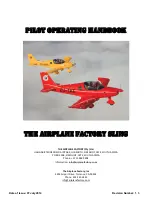
12
S E C T I O N 8 : T U N I N G A N D T R O U BL E S H O O T I N G
The Horizon ET has undergone a rigorous test-flying program in a wide range of
conditions. As a result, it is precisely tuned to achieve maximum flying performance.
Therefore, it should not be necessary to make any changes in your glider's tuning or
configuration. If however, you have any questions, please contact your authorized
North Wing dealer.
If any adjustments are made on your glider, we recommend that they be noted in
your Maintenance Log (Section 12 of this Manual). It is then easy to go back and
trace occasional problems.
Please bear in mind that certain adjustments, like the cross tube sweep setting, are
very critical and often create trade-offs in handling, performance, or --more
seriously-- safety.
The troubleshooting chart below offers you a first solution (first action to be
taken) and then a second (or more) solution for any possible problems you may
encounter.
Please investigate each problem as indicated by the chart. Never make more than
one change at a time. This is a basic rule in test flying, which allows you to better
keep track of the progress made.
We sincerely hope you never have to use this chart.
TROUBLESHOOTING CHART
SYMPTOM
1st solution 2nd solution
Tail heaviness (flies too slow)
B,D
H
Nose heaviness (flies too fast) B,C G
Right turn
B,A F, J
Left turn
B,A E, K
Yaw unstable (roll response lag)
L N
Roll unstable
B A, R
Roll stable
M O
Breaks left in stall
B J, P
Breaks right in stall
B K, Q
Trailing edge flutter
A,S O
Sail wrinkles
S M
Loose rigging
A
Tight rigging
A










































